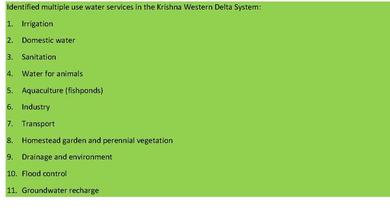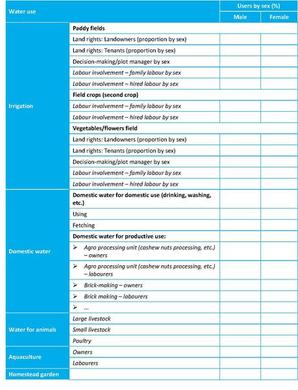Tool 4
TOOL 4. IDENTIFICATION OF WATER SERVICES AND USERS
To map the multiple water services provided by an irrigation scheme to different users, to identify who are the users of the different water services and to collect information on their socio-economic characteristics and their water rights.
Like Tool 3, this tool can be used to identify user groups and water services. Where Tool 3 takes livelihood groups as the starting point, this tool takes identified water services as the starting point.
OBJECTIVE
To map the multiple water services provided by an irrigation scheme to different users, to identify who are the users of the different water services and to collect information on their socio-economic characteristics and their water rights.
METHOD
Step 1: List the multiple-use water services
Information for this can be obtained by doing key-informant interviews and observations. An example of identified multiple uses of water provided by an irrigation canal in India can be found in Box 2.
Box 2 - Identified multiple water use services in the Krishna Western Delta System

Source: FAO, 2010. Mapping Systems and Service for Multiple Uses in Krishna Delta Western System Andra Pradesh – India. MASSMUS Application with special focus on domestic water supply and sanitation. Rome: FAO.
Step 2: Draw up a user matrix in a FGD or key informant interview
Explain the exercise to the focus group or key informants and draw up a matrix of four columns and eight rows (more can be added when needed). Include the identified water use services in the left column.
Step 3: Identifying key users
Identify with the focus group or key informants the different users for each water-user service and put these in the second column. For each water-use service estimate the proportion of users that are male and female. Include landowners, tenants, plot managers (who make the decisions) and labourers.
Step 4: Users and formal water rights
Using the matrix, discuss the following with the focus group or the key informants
- What proportion of male and female users of each water use service has formal water rights?
- Who are the users with formal water rights?
- What are reasons for not having formal water rights?
Step 5: Areas for further investigation
Based on discussions with the focus group or key informant, identify areas that require further investigation and reasons for this.
BASED ON
Tool 1 in: Wiegers, E., and Wahaj R., forthcoming. Multiple Uses of Water Services for Men and Women in Large Irrigation Systems: Engendering the MASSMUS approach, MASSMUS Gender Module, Rome: Food and Agriculture Organisation of the United Nations.
MASSMUS step 0 in: Renault, D. et al., forthcoming. Multiple uses of water services in large irrigation systems, Auditing and planning modernisation. The MASSMUS Approach. FAO ID 66, Rome: Food and Agriculture Organization of the United Nations.
Table 5 - Example of a User matrix

